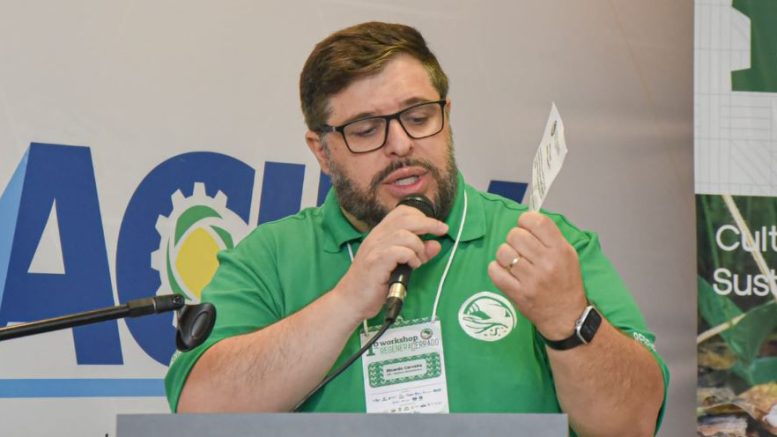“From an economic standpoint, regenerative agriculture promotes the reduction of chemical inputs…”
Ricardo Cerveira is the CEO of Instituto BioSistêmico (IBS), a non-profit institution dedicated to the application of technologies for family farming, agriculture, and the environment.
Cerveira is an advisor to the Instituto Brasil Orgânico (Brazil Organic Institute), an agronomist from Esalq/USP, with a M.Sc. in agroecology and sustainability in agriculture from USP and a doctorate in administration from Unicamp.
AgriBrasilis – What are the benefits of regenerative agriculture?
Ricardo Cerveira – Regenerative agriculture is a set of practices that goes beyond sustainability, as it seeks to restore and improve the health of agricultural ecosystems. Its benefits include soil conservation and regeneration, increased carbon sequestration, greater biodiversity, and ecosystem services such as pollination and natural biological pest control.
From an economic standpoint, regenerative agriculture favors the reduction of chemical inputs, which translates into lower production costs and greater crop resilience. In addition, it promotes safer and more nutritious food, aligning with consumer and market demands for more responsible and low environmental impact chains. It is no coincidence that the term is recognized by Brazilian legislation related to organic production.
AgriBrasilis – What is the Regenera Cerrado program and what are its objectives?
Ricardo Cerveira – Regenera Cerrado is an initiative launched in 2022, the result of collaboration between farmers, researchers, and private and public institutions. It is based in southwestern Goiás, with a focus on the scientific validation of regenerative practices and the dissemination of knowledge to new farmers.
The program is coordinated operationally by the BioSistêmico Institute, with scientific coordination by Embrapa and support from partners, universities (such as IFGoiano, UFLA, etc.), and companies in the sector (such as Cargill). In Phase I, 12 farms participated, covering 7,842 hectares, with more than 1,600 hectares monitored in detail. It is currently in the beginning of Phase 2, open to new partnerships and companies in the sector.
The main objectives are:
- to characterize sustainable agricultural practices already in use;
- to evaluate indicators of soil, biodiversity, carbon, and grain quality;
- to analyze the economic effects of the transition;
- to raise awareness and support new farmers.
The project is also directly linked to 10 of the UN’s Sustainable Development Goals, reinforcing its global contribution.
AgriBrasilis – What results stand out in soybean and corn crops?
Ricardo Cerveira – So far, the results are impressive. Among them:
- Use of inputs: 20% reduction in fertilizers, 30% in fungicides, and 50% in insecticides, replaced by high-efficiency bio-inputs.
- Pest control: regenerative practices have created more suppressive environments, with fungi, wasps, and viruses exercising natural control over soybean, corn, and sorghum caterpillars.
- Soil: regenerative areas showed a higher presence of glomalin, a protein linked to carbon structuring and sequestration, as well as a lower incidence of nematodes (Pratylenchus).
- Productivity and pollination: soybean crops near native areas produced grains up to 7% heavier, highlighting the role of bees and biodiversity.
- Carbon: organic carbon stocks in the soil increased by up to 13 tonnes per hectare, surpassing even areas of native Cerrado vegetation.
“…soils with better structure and higher organic matter content retain more water and promote deeper roots.”
AgriBrasilis – How do regenerative practices perform during periods of drought?
Ricardo Cerveira – Resilience is one of the pillars of regenerative agriculture. Analyses have shown that regeneratively managed areas are better able to maintain productivity even under significant rainfall differences. This is because soils with better structure and higher organic matter content retain more water and promote deeper roots. In practical terms, regenerative farms have shown greater production stability under water stress conditions, a crucial aspect in the face of climate change.
AgriBrasilis – How do production costs compare to the conventional system?
Ricardo Cerveira – Costs vary depending on the degree of adoption and the stage of transition. In some scenarios, especially in the beginning, there is a relative increase due to management adjustments. However, the economic results are clear: in 2022/23, regenerative agriculture yielded an additional R$ 2,356.16/ha in family farming, with a profitability 210% higher than the conventional system. In addition to the reduction in the use of chemicals, there are gains associated with production efficiency and the possibility of accessing differentiated markets, which are increasingly demanding in terms of traceability and sustainability.
AgriBrasilis – How have farmers responded?
Ricardo Cerveira – Farmers’ perceptions vary. Non-family farmers tend to adopt bio-inputs more quickly, while family farmers require greater technical support and clear economic demonstrations. The main barriers identified are the lack of specialized technical assistance and the influence of traditional suppliers of chemical inputs.
On the other hand, the recognized advantages include environmental preservation, cost reduction, increased productivity, and regulatory compliance. The dissemination of knowledge through field days, workshops, and the Caravana Regenera Cerrado (Cerrado Regeneration Caravan) has been fundamental in increasing confidence and adherence.
READ MORE:

